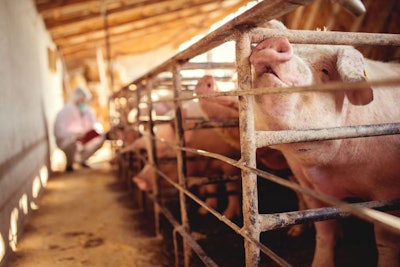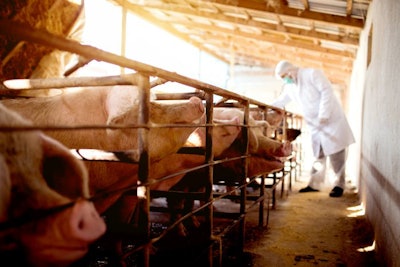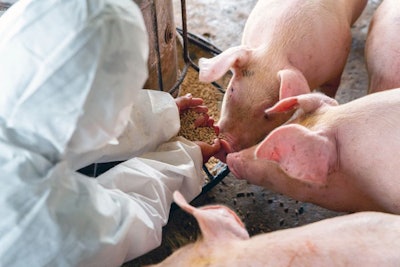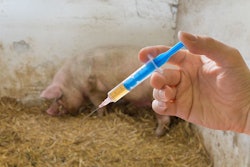
Rising commodity costs, disease challenges and sustainability shape 2021 global pig feed production
The 2021 Swine Feed Outlook analyzes the critical issues influencing global swine feed and pork production, including African swine fever (ASF) virus, commodity price volatility, trade, COVID-19 and consumer emphasis on sustainability.
ASF still dominates global pork markets
Since ASF was first detected in China in 2018, the highly contagious and fatal pig disease has spread to 26 countries. Without an effective vaccine or the ability to contain it, ASF remains the No. 1 threat to the global swine industry.
 Veterinarian examining pig with stethoscope farm for some disease, checking each pig health.
Veterinarian examining pig with stethoscope farm for some disease, checking each pig health.Here is a look at the current state of ASF by affected region:
- China
After losing half of its swine herd in first 18 months of the ASF outbreak, China touted a rebound in 2020, but suffered a resurgence in 2021. Despite China’s reports that the disease was under control and its efforts to rapidly restock its herd, the country experienced sizable losses in the winter of 2020-21, but to what extent is unknown.
“We get contradictory figures almost every day, so it’s difficult to know exactly what the impact will be, but it seems that, short term, the sow herd is down somewhere between 3% and 10% compared to previous months, but still higher than a year ago,” says Mathieu Cortyl, Tonisity International’s managing director for Europe & Asia-Pacific and the director of Tonisity China Holding Ltd.
Reports suggest new variants of the virus have emerged, which many suspect may be attributed to illegal vaccines.
“Early distribution of unproven and ineffective vaccines appear to have played a role — possibly setting back full containment of the disease multiple years,” says Christine McCracken, Rabobank executive director – animal protein.
The country has also dealt with a surge porcine epidemic diarrhea virus (PEDv) and porcine reproductive and respiratory syndrome (PRRS) outbreaks, which have increased the mortality rate of piglets and culling of sows and hogs.
Despite setbacks, pork production is anticipated to grow by 8% to 10% year over year in 2021, Rabobank reports. And China will continue to impact raw material demand worldwide, as 2021 hog feed consumption is set to increase by 11% compared with 2020.
“China [and Southeast Asia] have made tremendous progress in transitioning production to more biosecure facilities in a relatively short timeframe,” McCracken notes. “The magnitude of this transition is very difficult for much of the world to fully comprehend and is not fully complete, but it was a Herculean effort and will have a lasting structural impact on the global industry and its allied suppliers.”
With the high demand for pork and soaring piglet/sow prices, Chinese pig producers are investing in more than just heightened biosecurity.
“With good profitability and larger investments available for production, we are seeing a trend toward the use of higher-quality feed ingredients that provide both health and nutrition benefits,” reports Yanbin Shen, APC director of global technical service.
Long term, ASF will drive Chinese producers to further integrate and consolidate to better manage disease risk within individual systems, says Zach Rambo, North American swine manager, Zinpro Performance Minerals.
Sources suggest it will be at least three years before Chinese pork production returns to pre-ASF numbers.
- Southeast Asia
ASF continues to resurface in many Southeast Asian countries, most recently in South Korea, The Philippines, Indonesia, and Malaysia, the FAO reports.
Since many Southeast Asia pig producers lack the financial resources or basic infrastructure to limit ASF’s spread in the region, the ability to contain the virus will be an ongoing challenge, McCracken says.
On the bright side, Vietnamese pig production is slated to have a good year, with analysts forecasting feed demand 8% higher than in 2020.
- Europe
ASF has been found in 11 European countries, including its largest pork producer, Germany. The majority of European ASF outbreaks have been limited to the wild boar population and backyard farms; however, recently an outbreak on a Polish farm resulted in the culling of 16,000 pigs. Producers across the continent remain on high alert to prevent further crossover into commercial herds.
“ASF continues severely damaging the production in several countries of eastern and central Europe,” Cortyl says, noting China’s ban on German pork, which had been its No. 2 importer. As a result, Germany’s pork production is expected to decrease by 4% in 2021.
As ASF spreads in four restricted zones, the EU strategy is to establish disease-free corridors around the clusters with fences and wild boar hunting, Cortyl says.
Trade, demand uncertainty
Beyond the production challenges and losses ASF wreaks on pig producers, the virus also continues to disrupt global trade. Whether it is increased import demand from unaffected regions, e.g. Brazil, U.S. and Canada, or the uncertainty it causes in commodity markets, ASF has become the linchpin of all animal protein production forecasts and balance sheets.
“Major pig-producing countries are exporting increased amounts of pork to China to offset Chinese production losses,” Rambo says. “This is causing ripple effects into regional economies. Additionally, the loss of pigs on feed in China is impacting global grain markets as demand softens.”
The other virus, COVID-19, continues to influence global trade as countries and industries slowly recover. For example, export demand in markets struggling to rebound from the pandemic or where “unfavorable currency rates limit product competitiveness will face headwinds,” McCracken says.
Geopolitical relations will also shape commodity markets for the foreseeable future.
“Trade matters with Asia-Pacific as a whole and China, in particular, offer great opportunities if positive relations can be maintained,” Shen notes. In the U.S., for example, export opportunities will involve the removal of tariff and non-tariff barriers in Southeast Asia and in China.
On this front, pig industry stakeholders, such as the National Pork Producers Council (NPPC), will also continue to advocate for the removal of Chinese retaliatory duties.
“Similar to the Philippines and Vietnam, [Chinese] demand for pork has never been greater, creating an unprecedented sales opportunity for global pork exporters,” says Rachel Gantz, NPPC director of communications. “U.S. pork producers are uniquely positioned to fill the supply gap, but face a collective 33% tariff. Meanwhile, pork from competitor nations face only an 8% tariff, placing U.S. pork at a significant competitive disadvantage.”
High feed costs challenge margins
In 2021, the price of raw feed ingredients has spiked due to “lower supplies, strong exports and market volatility due to renewable diesel, which contributes to greater volatility in grain and oilseed markets,” McCracken explains.
Unfortunately, according to commodity market analysts, high feed costs may be here to stay.
“I’ve been asked a lot lately if this is the new commodity supercycle,” says Arlan Suderman, StoneX Group’s chief commodity economist. “The last commodity supercycle we had peaked in 2008 when the financial crisis was just getting started. They tend to come along about every 30 to 35 years — so this one would be early or premature — but there are a lot of things that are happening that raise red flags that we could be starting a new supercycle early. If that’s the case, users are going to have to be concerned about higher prices — maybe even higher than they are today, possibly much higher — for some months yet or even maybe several years.”
 Rat0007 | iStock.com
Rat0007 | iStock.comFeed manufacturers and nutritionists will be taxed to develop strategies to maximize profitability while maintaining or increasing animal health, Shen says, noting the added reliance on feed technologies to improve feed conversion, such as feed ingredients, additives or manufacturing advances.
“Balancing pork production, consumption and processing is a delicate exercise,” adds Jeroen De Gussem, marketing director at Adisseo.
McCracken agrees: “Tight global stocks heighten the need for successful harvests, but also increases the risk for producers, and concentrates attention on feeding efficiencies. Returns for the swine industry vary by geography and are driven by local supply-demand dynamics; however, regardless of the geography, all producers are facing higher costs of production due to feed.”
Pandemic effects on pork
Despite progress in the administration of several COVID-19 vaccines worldwide, the pandemic’s impact on pork production and demand lingers.
“As global economies emerge from the pandemic, not all will be facing the same economic reality,” McCracken says. “We have yet to face the full economic effect of business closures and the structural shifts resulting from the disruption due to COVID. The demand for pork and other proteins could shift as a result.”
As the foodservice industry recovers, regions that rely heavily on tourism will continue to struggle.
“Globally, I don’t think COVID-19 has had an impact on pork demand, but locally it can have a huge one,” Cortyl says.
The growing role of ‘sustainability’
Today, discussion of “sustainability” in animal agriculture encompasses more than its environmental impact. It spans to include animal health and welfare, efficiency, food safety, raw material sourcing and beyond. And sustainability — or the perception of sustainability — is increasingly becoming a deciding factor driving consumer support and how they spend their money.
“Pork consumption is impacted by the perception of being unsustainable and the lack of transparency in pork production,” De Gussem says. “But swine is a good value-added transformer of fiber-rich raw materials not easily usable by human beings and for food industry co-products. However, any scandal can suddenly alter the consumption behavior.”
Simon Carlton, Anitox technical director EMEA/AP, takes the sustainability discussion a step further to directly include a company’s longevity and profitability: “If your reputation becomes damaged, the sustainability of your brand suffers.”
To strengthen, maintain and grow the pork demand, transparency throughout the supply chain — including the feed — will be key.
“There’s huge pressure from the retailers, from consumers — and everybody wants to see everything,” De Gussem says. “We must be transparent. We have to be able to explain where products are coming from.”
In De Gussem’s opinion, a company’s response will help it differentiate itself from its competition, i.e. “who can commit to demands for transparency and those who cannot provide that information will be out of business.”
“I do expect [the pig industry] to remain under pressure unless we can find ways of feeding and producing pork in a more sustainable manner,” Carlton says. “The vegetarian movement is growing slowly — but it’s causing people to question what they eat. In the longer term, I see pressure continuing to impact all meats. It’s already started with beef and sheep, but then pork comes next.”
Government regulations are also influencing live production practices and feeding programs. For example, Rambo notes, the EU’s phaseout of pharmacological levels of zinc oxide (Zn), which has long been to mitigate post-weaning diarrhea and improve nursery performance.
2021 swine feed volumes
Challenges aside, the demand for pork remains high worldwide, which points to growth, if moderate, for global pig feed production in 2021.
“Based on a gradual 1.2% increase in the global hog population, feed production volumes should move in tandem,” McCracken says. “Based on expectations for feed cost inflation and the focus on feed conversion, we would expect growth in global feed needs to trail herd numbers slightly.”
References available upon request.
Fighting the spread of foreign animal diseases
In addition the acceleration of pig industry consolidation in some regions, ASF has perhaps forever changed how some countries approach biosecurity and risk mitigation. ASF has challenged foreign animal disease (FAD) preparedness in many countries and forced improvements.
In the U.S., for example, it has led to the development of national FAD response, FAD PRep.
ASF also enhanced the exploration and implementation of feed biosecurity best practices across the supply chain. For example, “individual production systems are implementing supply-quarantine procedures on certain ingredients to mitigate FAD risk,” he notes.
For the latest research on ASF in feed and feed ingredients, visit https://bit.ly/3tkJwFh.
View our continuing coverage of the African swine fever outbreak.


















